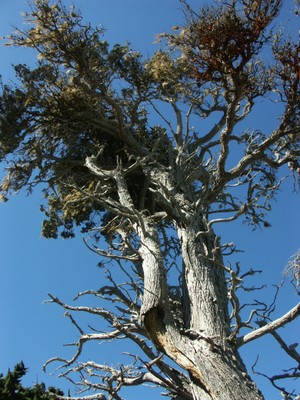Study Compares Rarity and Evolutionary Distinctiveness of Trees in Protected and Unprotected Areas
How should tree species and forests be prioritized for conservation? In a paper published in the journal Biological Conservation, a researcher recommends considering both the rarity of tree species and their evolutionary distinctiveness.
 Among the most important objectives of conservation is ensuring that an
ecosystem is resilient to disturbances and provides as many different functions
as possible. According to an assessment by an Eastern Forest Environmental
Threat Assessment Center cooperating scientist, those qualities can be
quantified using two metrics: rarity and evolutionary distinctiveness. Rarity
is an indicator of vulnerability from a wide range of threats, while
evolutionary distinctiveness is a measure of how closely related a species is
to its relatives and ancestors and is important because evolutionarily distinct
species may have unique characteristics and forest functions. A study published
in the journal Biological Conservation
combined species-level measures of rarity and distinctiveness of U.S. trees
with information from about 130,000 Forest Inventory and Analysis plots to
quantify the degree of tree rarity and evolutionary distinctiveness across U.S.
forests. The results indicate that forests near the West Coast and in the South
have high measures of both. Rarity was higher, on average, in forests in
unprotected areas, while evolutionary distinctiveness was higher in protected
forests. This information can help guide which forests to target for proactive
management activities and monitoring efforts.
Among the most important objectives of conservation is ensuring that an
ecosystem is resilient to disturbances and provides as many different functions
as possible. According to an assessment by an Eastern Forest Environmental
Threat Assessment Center cooperating scientist, those qualities can be
quantified using two metrics: rarity and evolutionary distinctiveness. Rarity
is an indicator of vulnerability from a wide range of threats, while
evolutionary distinctiveness is a measure of how closely related a species is
to its relatives and ancestors and is important because evolutionarily distinct
species may have unique characteristics and forest functions. A study published
in the journal Biological Conservation
combined species-level measures of rarity and distinctiveness of U.S. trees
with information from about 130,000 Forest Inventory and Analysis plots to
quantify the degree of tree rarity and evolutionary distinctiveness across U.S.
forests. The results indicate that forests near the West Coast and in the South
have high measures of both. Rarity was higher, on average, in forests in
unprotected areas, while evolutionary distinctiveness was higher in protected
forests. This information can help guide which forests to target for proactive
management activities and monitoring efforts.
Pictured: Monterey cypress is among the numerous rare and
evolutionarily distinct tree species that grow in California. Photo by Kevin Potter, North Carolina State University.
Related publications:
Forest Service Partners/Collaborators: Forest Inventory and Analysis
Contact: Kevin Potter, North Carolina State University Cooperating Scientist, kevin.potter@usda.gov



